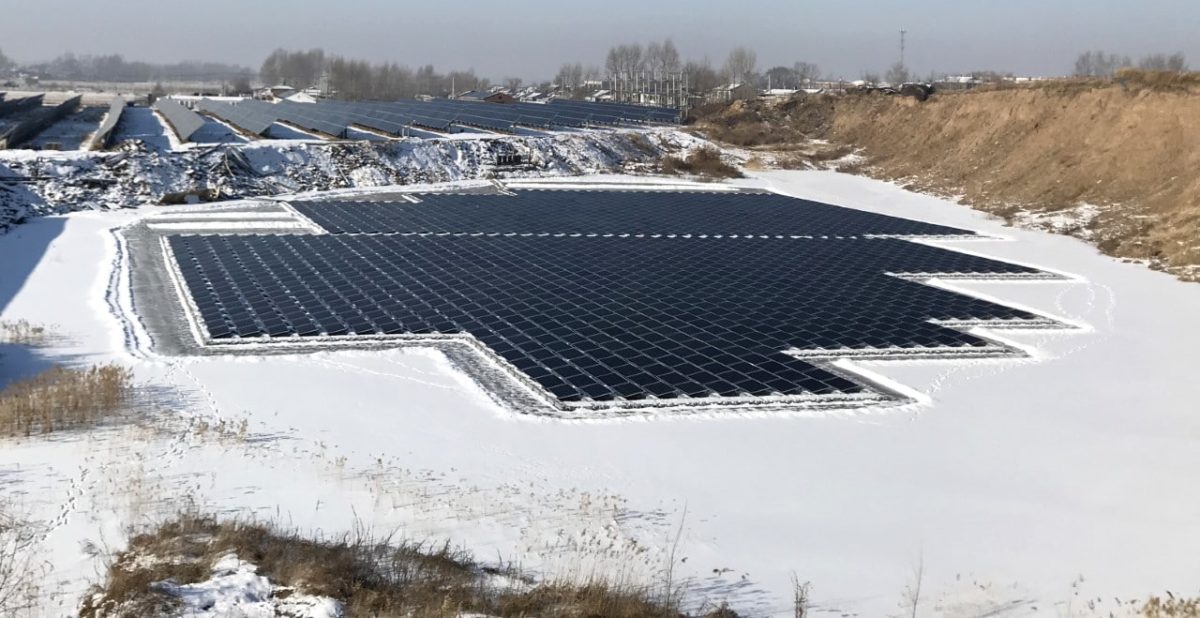Sungrow Floating, a unit of Chinese inverter maker Sungrow, built a 500 kW floating PV array on a water surface located in Bayan County, Heilongjiang Province, in Northeast China, where temperatures in winter can reach -20 degrees Celsius. The plant covers around 90% of the water surface of a lake and the company has explained what happens to the PV system during freezing times.
“The lake freezes for about four months from November to March each year,” Kane Wang, manager of system solution department at Sungrow Floating, told pv magazine. “During the freezing period of lake water, the entire array will be frozen.”
The ice layer may be squeezed and uplifted where it is thicker, and the floating PV system is fixed on the surface of the ice layer, Wang noted. The anchorage construction in extremely cold areas is usually installed before temperatures reach the freezing point. “If the installation is required in the freezing period under special circumstances, the corresponding ice-breaking plan shall be adopted first, and the ice shall be removed before construction,” Wang explained. “At the same time, the influence of floating ice and frost heaving on the floating array should be considered in the design of anchorage system.”
When using concrete piles or gravity anchors as underwater anchoring material, the frost heave resistance of concrete should also be considered. When using a shore anchor, it is necessary to consider the squeezing and floating effects of freezing on the anchor. These are different from those of an anchoring system in non-freezing areas.
Wang also highlighted that extremely cold areas are often accompanied by high snow loads, which necessitate special anchoring materials, relatively slow construction efficiency, and a higher project cost than that of conventional floating PV projects. “Then the technical requirements for the floating system are more important,” he added. “For instance, a larger buoyancy-weight ratio should be considered in the design, and the floating body can be flexibly adjusted base on the difference of snow load in each area.” The quantity of the floating body can be increased or reduced based on the local snow load to realize the adjustable buoyancy per unit area so as to achieve the optimal system cost, he pointed out.
Sungrow Floating says its products comply with the key requirements of extremely cold and freezing areas. “The product materials need to be able to resist extreme low temperature so that brittle cracking or fracture will not occur,” the manager stated. “The structure design also needs to consider the influence of frost heaving.” That means that the entire array structure needs to have enough strength to resist freezing, and needs to be verified by a series of freezing tests and temperature cycle tests.
The selected components must also have the ability to resist heavy snow loads and sufficient safety buoyancy must be considered. “Finally, in terms of the anchoring system, it is necessary to consider the impact load of the floating ice on the array as well as the safety of the anchoring construction during the freezing period and temporary anchoring measures to ensure that the floating system will not have failure and accident damage,” Wang said.
Furthermore, he specified that the low temperature during the freezing periods will increase the power generation of the floating system. The plant was commissioned in 2018 on a water surface of around 5,000 square meters. It relies on Sungrow inverters ranging in power from 60 to 80 kW and solar modules with power output between 275 and 315 W provided by an unnamed manufacturer.
This content is protected by copyright and may not be reused. If you want to cooperate with us and would like to reuse some of our content, please contact: editors@pv-magazine.com.




Interesting Topic, but the provided information are kind of obvious.
It basically says that you have to consider cold temperatures for the materials, that water freeze and snow falls in the winter. Oh really? You don’t say..
I am missing some real insights like extra Capex or opex in comparison with other floating PV. Special influences e. g. for the modules etc.
spot on – no really, was thinking same thing. Enough said !!
Thanks for sharing this information.